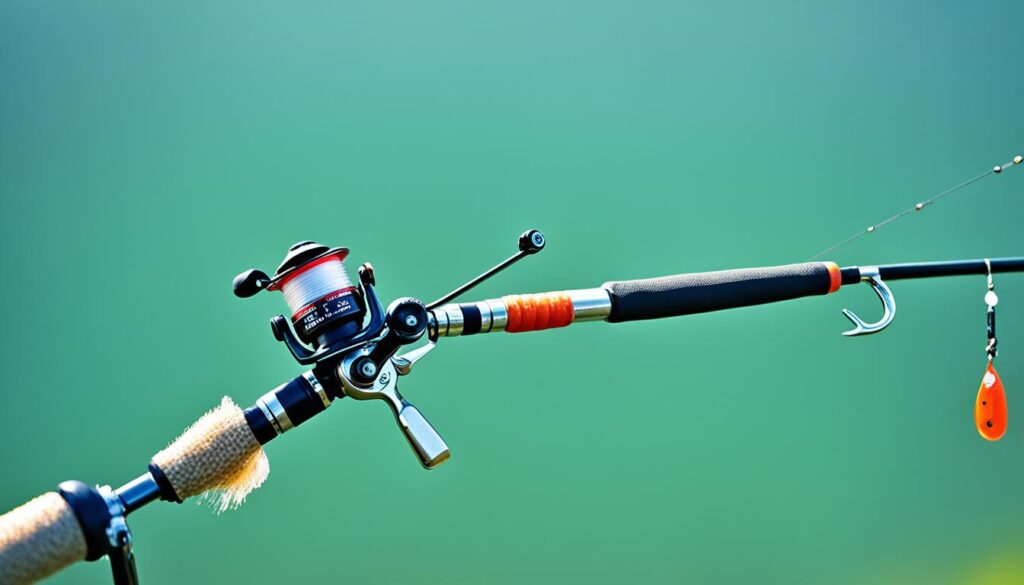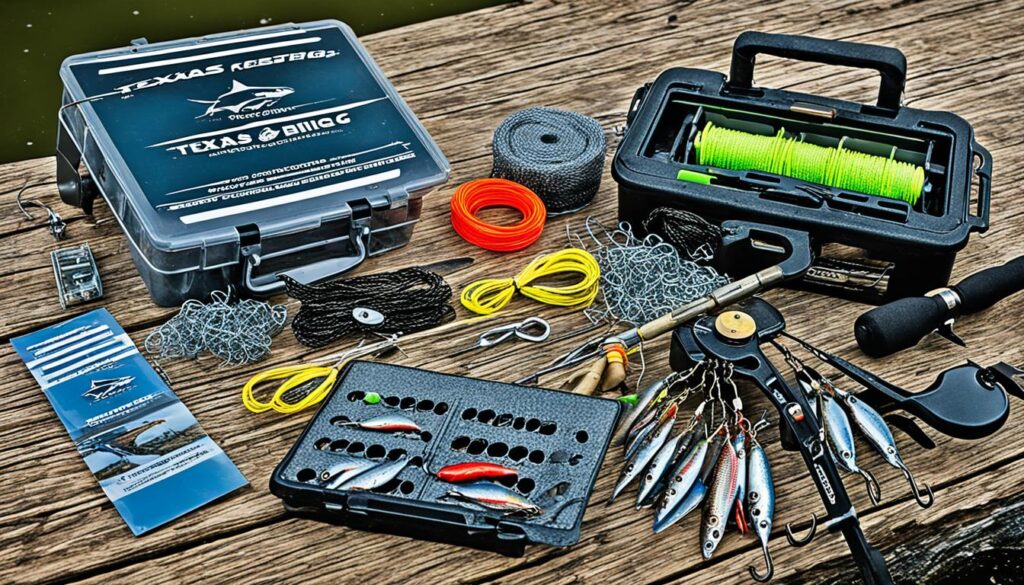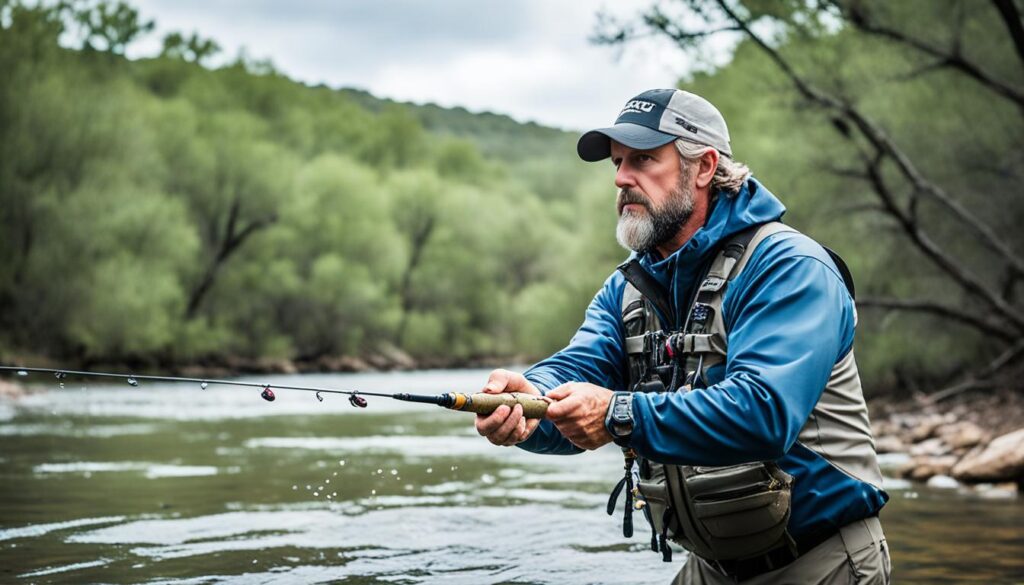The Texas rig is perfect for fishing in thick cover without getting stuck. It’s great for both expert anglers and beginners. This guide will teach you to use the Texas rig like a pro. We’ll cover the main parts, how to set it up, fishing methods, and what gear to use.
Key Takeaways:
- Learn the essential components of the Texas rig, including the bullet-shaped weight, offset or straight shank hook, and soft plastic bait.
- Follow the rigging steps, such as threading the hook, burying the point, and ensuring a weedless presentation.
- Choose the right hooks and weights based on the size of your bait and the fishing conditions.
- Optimize your setup with the appropriate rod, reel, and line for Texas rig fishing.
- Explore different fishing techniques, such as the long cast retrieve and the slow dragging retrieve.
Understanding the Texas Rig Components
The Texas rig is a popular fishing setup with three key parts: a bullet-shaped weight, an offset or straight shank hook, and a soft plastic bait. Each part is vital for the rig’s effectiveness. You can change these parts based on the fishing conditions and your bait choice.
The bullet-shaped weight makes the bait sink to the right depth. You can adjust the weight for different water depths and conditions. Tungsten weights are preferred because they transmit contact well and make the lure move naturally.
The hook goes through the soft plastic bait and hooks the fish. You can use offset worm hooks for thin worms or straight shank hooks for bigger baits like creature baits. It’s key to pick the right hook size and style for your bait.
The soft plastic bait attracts the fish. There are many shapes and sizes, like creature baits, big worms, and craws. These baits look real and move in a way that attracts fish, raising your chances of catching something.
To help you understand better, here’s a picture showing the Texas rig components:
| Component | Description |
|---|---|
| Bullet-shaped weight | Helps the bait sink to the desired depth and provides a natural lure action. |
| Offset or straight shank hook | Threaded through the soft plastic bait and provides the point of contact for hooking the fish. |
| Soft plastic bait | Mimics natural prey and attracts the fish with its lifelike appearance and enticing action. |
By knowing how each part works, you can create a Texas rig that fits your fishing needs. Try different part combinations to discover what works best for you.
How to Rig a Texas Rig
Setting up a Texas rig is pretty straightforward. You just need to follow a few important steps. Doing this will make sure your rig is ready to catch fish. Let’s look into how to set one up properly!
Step 1: Threading the Hook
To start, you’ll thread the hook into your bait. Push the hook through the bait’s nose and out the side, about 1/8 to 1/4 inch down. This step is key to get the hook in the right spot.
Step 2: Pulling the Hook Through
Next, pull the hook through the bait until the hook’s eye is at the bait’s nose. This makes the bait look real in the water. It’s important for catching fish.
Step 3: Burying the Hook Point
The last step is to hide the hook point inside the bait. This keeps the rig from getting stuck in weeds. Ensure the bait is straight on the hook, and the hook point is hidden. This makes your rig work best.
Learn these steps well to quickly set up a Texas rig. Care and precision in rigging can increase your chances of a good catch. Practice makes perfect!
Now you know the setup, it’s time to fish. Take your gear and try out this method. Happy fishing with your new Texas rig!
Choosing the Right Hooks and Weights for a Texas Rig
Choosing the right hooks and weights is key for your Texas rig’s success. Here’s what you need to look at:
Texas Rig Hooks
Offset worm hooks and EWG hooks are top choices for a Texas rig. Offset worm hooks have a 90-degree elbow, perfect for rigging thin worms. EWG hooks work well with larger soft plastics like creature baits. Both ensure a great hookup with the fish.
Texas Rig Weights
Tungsten weights are the best choice for your Texas rig. They have several advantages over lead, like better feel of the bottom. They come in various sizes, but the bullet-shaped slip sinker is most common. This shape helps the rig slide through cover while looking natural. It’s important to adjust the sinker’s weight so your bait reaches the right depth.
To improve your Texas rig, pick the right hooks and weights. Try different combinations to see what fits your fishing style and the conditions you encounter.
| Texas Rig Hooks | Texas Rig Weights |
|---|---|
| Offset worm hooks | Tungsten weights |
| EWG hooks | Bullet-shaped slip sinker |
Selecting the Right Setup for Texas Rig Fishing

The setup for Texas rig fishing changes with your likes and the fishing scene. You may like a baitcaster or spinning gear. It’s key to pick the best rod, reel, and line mix.
Choosing the Right Rod and Reel
A medium-heavy power rod, around 7 feet long, is best. It gives you power for big fish and helps with precise casts. A baitcasting reel with a fast gear ratio (7:1 or more) is great for quick line pulling and control.
Considering Line Selection
Choosing the right line is vital in Texas rig fishing. A 15-20-pound test fluorocarbon line is often chosen for its invisibility and feel. It lets you sense gentle bites and gives good pressure during hooksets. For clear water or deep fishing, use a lighter line for a better bait look.
Try different setups to see what works for you and the fishing spot. With the perfect rod, reel, and line, you’re ready to catch any bass you face.
Techniques for Fishing a Texas Rig
There are two key ways to fish a Texas rig for success: the long cast and the slow drag. These methods can really up your fishing game.
The Long Cast Retrieve
Want to cover more water and reach distant fish? The long cast is your best bet. Here’s the rundown:
- Throw your line far towards the spot you’re aiming for.
- Wait for the bait to sink all the way down.
- Lift your rod so the bait swims up, then let it drop while reeling in the slack.
This makes your bait move in a way that looks real to fish, tempting them to bite. It’s perfect for finding fish or when they’re not close to the bottom.
The Slow Dragging Retrieve
If fish are sticking close to the bottom, try the slow drag. Here’s how:
- Let your bait reach the bottom after casting.
- Gently pull it towards you, little by little, in a sweeping move.
Keeping your rod ahead helps you control the bait and set the hook fast. This method is great for bottom-feeders or in spots with lots of plants.
Choose your method based on where you are and what the fish are doing. Trying both the long cast and slow drag lets you find what works best. This can really help you catch more.
Every fishing spot is different, so be ready to change your approach as needed. The most important things are to be patient, watchful, and flexible. Enjoy your fishing!
| Technique | When to Use |
|---|---|
| Long Cast Retrieve | When fish are suspending off the bottom or when you need to cover a larger area |
| Slow Dragging Retrieve | When fish are holding tight to the bottom or in areas with heavy cover |
Modify Your Texas Rig for Better Performance
You can make your Texas rig work better by tweaking it a bit. These tweaks can stop it from snagging and get more fish interested. Let’s talk about some cool ways to change your Texas rig:
Add a Bobber Stop
One smart move is to put a bobber stop before the slip sinker. This keeps your setup from tangling up. It lets your rig move smoothly through weeds and around objects, making it easier to catch fish without trouble.
Include Noise Attractors
Adding things that make noise, like beads or rattles, is another great idea. These noises make your rig easier for fish to find and more tempting. Try out various noise makers to discover which ones fish like the most in your spot.
Try Tex-posing
Tex-posing is a favorite tweak for those using a Texas rig. You push the hook through the bait and slightly into it. This makes hooking fish easier.
But, it might get snagged more, so use it wisely. Every fishing spot is different. The aim is to adjust your Texas rig to meet those challenges. By making these changes, your Texas rig will do better, giving you a better chance at a great fishing day.
Tips for Texas Rig Fishing Success
Ready to up your Texas rig fishing game? Here’s how you can catch more fish:
- Use a natural presentation: Pick a bait color that looks like the fish’s usual food. It tricks the fish into biting more often.
- Experiment with retrieve speeds and techniques: Mix up how fast and how you move your bait. Sometimes slow and smooth works best, and other times quick and jerky gets their attention. Be ready to change it up based on the day.
- Pay attention to structure and cover: Fish love hiding near things like underwater plants, fallen trees, or rocks. These spots are their favorite places to eat. Casting near these areas can up your chances of a catch.
- Be patient and persistent: Fishing with a Texas rig takes time. You have to revisit spots and wait for the fish. If they’re not biting right away, don’t worry. Keep trying, and keep your focus.
- Stay adaptable: Change your setup and how you fish based on what the fish are doing and the day’s conditions. If one method’s not working, switch it up. Being ready to adjust is crucial for successful Texas rig fishing.
Follow these steps to become skilled at Texas rig fishing. Remember, fishing is about learning and experimenting. The more you try, the better fisherman you’ll be. So, hit the water, use these tactics, and enjoy catching bass with your Texas rig!
Gear and Equipment Recommendations

For catching fish with a Texas rig, it’s important to pick the right tools. Here are some top choices:
Hooks
- VMC Worm Hooks
- BKK Basilisk Worm Hooks
- Lazer Trokar HD Worm Hooks
These hooks are great for Texas rigging. They go through fish easily and keep your bait in place.
Weights
- WOO! Tungsten Never Chip Flipping Weights
- Gamakatsu G-Shield Tungsten Weights
- Ark No Chip No Insert weights
Tungsten weights work best for this type of rig. They make your bait feel more natural due to their weight and sound.
Line
The best line to use is a 15-20-pound fluorocarbon. It’s hard for fish to see and helps you feel when they bite.
Rod
A 7-foot Medium Heavy rod is a good choice. It makes casting easier and can handle big fish with its strength. This rod is also good for many Texas rig techniques.
Reel
Choose a fast baitcasting reel with a gear ratio of 7:1 or more. It helps you pull in your line fast when you catch a fish.
Gloves
Wear heavy-duty gloves to protect your hands from cuts and sunburn. They make fishing safer and more comfortable.
Getting the right gear makes Texas rig fishing better. You’ll catch more fish and have fun doing it.
Recommended Gear and Equipment
| Gear | Recommendations |
|---|---|
| Hooks | VMC Worm Hooks, BKK Basilisk Worm Hooks, Lazer Trokar HD Worm Hooks |
| Weights | WOO! Tungsten Never Chip Flipping Weights, Gamakatsu G-Shield Tungsten Weights, Ark No Chip No Insert weights |
| Line | Fluorocarbon line in 15-20-pound test |
| Rod | 7-foot Medium Heavy rod with some tip action |
| Reel | Fast baitcasting reel with a high gear ratio (7:1 or higher) |
| Gloves | Heavy-duty gloves |
Advantages and Limitations of Texas Rig Fishing
Texas rig fishing has many advantages, making it a favorite among anglers. Its design prevents it from snagging in thick cover. The rig’s bullet shape and weedless style allow for easy movement through obstacles. This lets you reach bass in places where other rigs might get stuck.
The Texas rig is also very adaptable and works well in different places. You can use it in creeks, ponds, or big lakes. It suits many soft plastic lures, letting you change your approach based on the fish and location.
Using the Texas rig can help you catch big bass. The bait looks natural, and you can fish where bass like to hide. This makes the Texas rig a good choice, whether you’re just starting or have lots of experience.
“The Texas rig is my go-to setup for targeting bass in heavy cover. It allows me to fish confidently through thick vegetation and catch those elusive big bass.” – Pro Angler, John Smith
But, Texas rig fishing isn’t perfect for every situation. In places where fish are cautious, it might not work as well. Sometimes, using smaller baits with a different technique does better. It’s important to watch the water and switch methods if needed.
Knowing when to use the Texas rig is key. It’s great for fishing in dense cover. But in open water or light cover, you might want to try something else. Understanding this will guide you to use the Texas rig when it’s most likely to catch fish.
Overall, the Texas rig is a top choice for many anglers. It’s versatile and effective for catching bass in various situations. While it has some downsides, its benefits like being able to fish in cover, being adaptable, and catching big bass make it a go-to. By learning how to use the Texas rig properly, you can increase your chances of getting a big catch.
Conclusion
The Texas rig is an amazing way to fish for bass. It works well in many places. Learning how to use it means you can fish almost anywhere. Soft plastic baits can sneak through heavy cover to get bass. This rig lets you change things up depending on where you’re fishing.
Fishing with the Texas rig can be fun and effective. But you need the right hooks and weights. Find the best setup for you and try different ways to move your bait in the water. Sometimes, you might have to fish slower, but that’s okay.
Want to catch big bass? Try the Texas rig. Many bass fishers love it for its flexibility. It’s great for lakes, ponds, and rivers. So, pick up your fishing gear and explore your favorite spot. Enjoy your time fishing with the Texas rig. Here’s to happy fishing!
FAQ
What is the Texas rig?
The Texas rig is a great way to fish without getting stuck. It uses a special weight, a hook, and a soft bait. This setup helps you fish in thick places.
How do you rig a Texas rig?
To make a Texas rig, you start by pushing the hook into the bait’s nose. Then, bring the hook out the side, and hide the hook point inside the bait. This keeps it from catching on stuff.
What hooks and weights are recommended for a Texas rig?
Use offset worm hooks or EWG hooks for a Texas rig, based on your bait size. For weights, bullet-shaped slip sinkers made of tungsten are best. They help you feel the bottom better.
What setup is best for Texas rig fishing?
The best setup includes a medium-heavy rod about 7 feet long. Pair it with fluorocarbon line that’s 15-20 pounds. This combo works great for Texas rigs.
What are the techniques for fishing a Texas rig?
You can cast far and swim the bait off the bottom or drag it slowly. For the slow drag, move the bait just a bit at a time. These two ways are key for fishing a Texas rig.
Can you modify a Texas rig for better performance?
Yes, you can tweak a Texas rig for better results. Try adding a bobber stop or something to make noise. Another tweak is Tex-posing, putting the hook on the bait’s back.
What are some tips for success when fishing a Texas rig?
For success, use realistic bait and try different speeds. Also, fish around structures, be patient, and adjust your method with the conditions. These tips can really help.
What gear and equipment are recommended for Texas rig fishing?
For Texas rigs, get some offset worm hooks or EWG hooks. Use tungsten weights, a medium-heavy rod, a fast reel, and fluorocarbon line. Don’t forget gloves to protect your hands.
What are the advantages and limitations of Texas rig fishing?
Texas rigs are great for fishing in heavy cover and different places. They can land you big bass. But, they might not work as well in busy spots or when you need a subtle approach.
What is the summary of the Texas rig?
The Texas rig is perfect for fishing in tough spots. It uses a unique weight, hook, and bait combo. Knowing how to set it up and use it right can make your fishing trips successful and fun.
